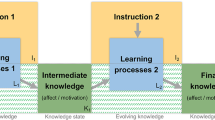Abstract
WHEN DRIVEN BY SIMPLE MODELS of information processing, reading instruction focuses on basic decoding skills centering on words and sentences. Factoring in advanced cognitive studies adds at least two more dimensions. First, readers must learn a collection of strategies for constructing meaning from text. Second, and most important, readers must develop enough situational awareness to diagnose a text and know which strategy to deploy.
Teaching intellectual crafts that involve not only base-line performative skills but also a repertoire of problem-solving heuristics—and the metacognitive maturity to orchestrate multi-leveled activities—works well in a master-apprentice model. However, one-on-one instruction is far too labor-intensive to be commonplace in the teaching of reading. Classroom innovations (e.g. collaborative learning) and redefined roles for teachers (e.g. reciprocal teaching) help to create more active learners. Also, newly-devised “learning environments” use computer software to mediate between the student and the task by dynamically adjusting the cognitive demands so that the student is always challenged but never overwhelmed.
This paper describes a computerized learning environment for teaching the conceptual patterns of critical literacy. While the full implementation of the software treats both reading and writing, this paper covers only the reading aspects of R-WISE (Reading and Writing in a Supportive Environment).
Similar content being viewed by others
References
Armbruster, B.B., & Anderson, T.H. (1982). Idea-mapping:The technique and its use in the classroom, or simulating the “ups” and “downs” of reading comprehension. (Tech. Rep. No. 36). Urbana: University of Illinois, Center for the Study of Reading.
Armstrong, J.O., & Armbruster, B B. (1991).Making frames for learning from informational text. (Tech. Rep. No. 542). Urbana: University of Illinois, Center for the Study of Reading.
Bretzing, B.B., & Kulhavy, R.W. (1979). Note taking and depth of processing.Contemporary Educational Psychology, 4,145–153.
Bretzing, B.B., & Kulhavy, R W. (1981). Note-taking and passage style.Journal of Educational Psychology, 73, 242–250.
Britton, B.K., Glynn, S.M., & Smith, J.W. (1985). Cognitive demands of processing expository text: A cognitive workbench model. In B.K. Britton & J.B.
Black (Eds.),Understanding Expository Text: A Theoretical and Practical Handbook for Analyzing Explanatory Text (pp. 227–248). Hillsdale, NJ: Lawrence Erlbaum Associates.
Clarke, J.H. (1991). Using visual organizers to focus on thinking.Journal of Reading, 34(7), 526–534.
Flavell, J.H. (1987). Speculations about the nature and development of metacognition. In F.E. Weinert, & R.H. Kluwe (Eds.),Metacognition, Motivation, and Understanding (pp. 21–29). Hillsdale, NJ: Lawrence Erlbaum.
Garner, R. (1987).Metacognition and reading comprehension. Norwood, NJ: Ablex.
Jones, B.F., Tinzmann, M.B., Friedman, L.B., & Walker, B.B. (1987).Teaching Thinking Skills: English/Language Arts. Washington, DC: National Education Association.
Jones, B.F., Pierce, J., & Hunter, B. (1989). Teaching students to construct graphic representations.Educational Leadership, 46(4), 20–25.
Palinscar, A.S., & Brown, A L. (1985). Reciprocal teaching: Activities to promote ‘reading with your mind.’” In T. L. Harris & I. J. Cooper (Eds.),Reading, Thinking and Concept Development: Strategies for the Classroom (pp. 147–160). New York: The College Board.
Paris, S G., Cross, D.R., & Lipson, M.Y. (1984). Informed strategies for learning: A program to improve children’s reading awareness and comprehension.Journal of Educational Psychology, 76, 1239–1252.
Salomon, G. (1988). AI in reverse: Computer tools that turn cognitive.Journal of Educational Computing Research, 4(2), 123–139.
Salomon, G., Globerson, T., & Guterman, E. (1989). The computer as a zone of proximal development: Internalizing reading-related metacognitions from a rèading partner.Journal of Educational Psychology, 81(4), 620–627.
Salomon, G., Perkins, D.N., & Globerson, T. (1991). Partners in cognition: Extending human intelligence with intelligent technologies,Educational Researcher, 20(3), 2–9.
Scardamalia, M., Bereiter, C., McLean, R S., Swallow, J., & Woodruff, E. (1989). Computer-supported intentional learning environments.Journal of Educational Computing Research, 5(1), 51–68.
Tierney, R.J., & Cunningham, J.W. (1984). Research on teaching reading comprehension. In P. D. Pearson (Ed.),Handbook of Reading Research (pp. 609–655). New York: Longman, Ltd.
Vygotsky, L.S. (1978).Mind in society: The development of higher psychological processes. Cambridge, MA: Harvard University Press.
Weinert, F.E., & Kluwe, R.H. (Eds.). (1987).Metacognition, motivation, and understanding. Hillsdale, NJ: Lawrence Erlbaum.
Zellermayer, M., Salomon, G., Globerson, T., & Givon, H. (1991). Enhancing writing-related metacognitions through a computerized writing partner.American Educational Research Journal, 28(2), 373–391.
Author information
Authors and Affiliations
Corresponding author
Additional information
ABOUT THE AUTHORS
Patricia Carlson holds a joint appointment at the Air Force Armstrong Laboratory (Intelligent Training Branch) and at Rose-Hulman Institute, where she is a professor. She did her undergraduate work at the College of William and Mary in Williamsburg, Virginia, and received the M.A. and Ph.D. degrees from Duke University. She has taught at the U.S. Naval Academy, The American University, and Rose-Hulman Institute. Additionally, Carlson taught at the University of Iceland as a Fulbright professor, and served as an adjunct professor at the Graz University of Technology in Austria. She has done consulting for a number of private companies. Her current areas of interest include the integration of intelligent hypertext systems and neural networks; hypertext as a form of knowledge representation; intelligent tutoring systems and learning environments; and all forms of computer-suported advanced media, including virtual reality technology.
Veronica Larralde received a Bachelor of Science degree in Computer Science from Trinity University in San Antonio, Texas. Since 1992 she has been working on the Fundamental Skills Training (F.S.T.) research project being conducted by the United States Air Force Armstrong Labs at Brooks Air Force Base, Texas. The F.S.T. project involves the development, testing and research of three adaptive tutors: Math Tutor, Reading and Writing in a Supportive Environment (R-WISE), and a Science Tutor. Ms. Larralde has also done design work for some GUIs used in the R-WISE tutor, as well as some of the illustrations in the Math Tutor CBT modules.
Rights and permissions
About this article
Cite this article
Carlson, P.A., Larralde, V. R-wise: A learning environment for teaching reading comprehension. J. Comput. High. Educ. 6, 74–98 (1995). https://doi.org/10.1007/BF02941039
Issue Date:
DOI: https://doi.org/10.1007/BF02941039




